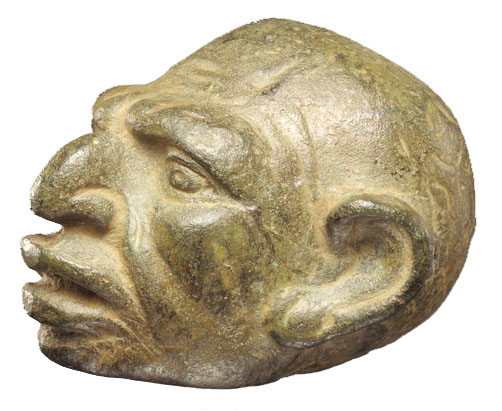
-
Copyright credit: J. Paul Getty Museum

ARCHAEOLOGICAL DESCRIPTION OF THE WEIGHT
Authority
Mint
Denomination
Material
Copper alloy (bronze or brass)
Manufacture
Cast
Shape
Human bust or head
Length
3.18 cm
(1.25 inch)
Width
4.60 cm
(1.8125 inch)
Height
- cm
Metrology
| Mass (g) | Mass (grain) | Date of measurement | Reference | fragmented | cleaned | reference weight |
|---|---|---|---|---|---|---|
| 192.01 | 2963.1004 | - | www.getty.edu | No | No | Yes |
Iconography
| Symbol | Technique | Direction | Position | Number | Synecdoche |
|---|---|---|---|---|---|
| Male figure | Shaped | Head |
Wear
Corrosion
Handle
No
Suspension hole
No
Recarved mould
No
Recarved weight
No
Intentionally destroyed
No
Archaeological description
With his thick lips, large ears, prominent nose, and receding forehead, the man depicted on this weight embodies all the features the Greeks and Romans found unattractive. The man's head is shaven except for a long lock in the back, now mostly missing. This lock of hair, called a cirrus, marks the man as a slave. In the Aristotelian philosophy popular at the time, it was believed that a person's inner qualities, like character and intelligence, were mirrored by their exterior appearance. Beginning in the Hellenistic period in the late 300s B.C. and continuing into the Roman period, such grotesques and exaggerated caricatures were quite popular.
Designed for use with a steelyard scale, this weight is a miniature sculpture with a hollow cast bronze outer shell. The interior was then filled with lead to give the proper weight. Steelyard weights often took the form of heads or busts. Originally, the man's single lock of hair served as a loop by which this weight was suspended.
Designed for use with a steelyard scale, this weight is a miniature sculpture with a hollow cast bronze outer shell. The interior was then filled with lead to give the proper weight. Steelyard weights often took the form of heads or busts. Originally, the man's single lock of hair served as a loop by which this weight was suspended.
Autopsy
No
INSCRIPTION
| Language | Technique | Legend type |
|---|
Fac simile
Edition
Monogram
ARCHAEOLOGICAL CONTEXT
Findspot (region)
Findspot (site)
context
CIRCUMSTANCES OF ACQUISITION
Region
City
Date of first acquisition
circumstances
Gift of Barbara and Lawrence Fleischman (New York, 1925 - New York, 1997) to the J. Paul Getty Museum in 1996. Sold (from Robin Symes) in Antiquities and Islamic Art, Sotheby's, New York, June 18, 1991, lot 152A, to Barbara and Lawrence Fleischman.
DATING OF THE WEIGHT
Curatorial Section
GREEK
,
ROMAN
Time frame
Comments on Chronology
About 1st century B.C. - 1st century A.D.
COLLECTION HISTORY
Collection
| Name | Date of acquisition | Inventory number |
|---|---|---|
| Fleischman Collection | Jan. 1, 1990 | F265 |
| Getty Museum – Getty Villa (Malibu) | Jan. 1, 1996 | 96.AC.156 |
| Symes Collection | None |
Bibliography
| Reference | Page/Column | Reference (number) | Plate / Figure | Comment |
|---|---|---|---|---|
| Auction Sotheby’s 1991 | 152A | (non vidi) | ||
| True and Hamma 1994 | 220 | 109 | ||
| Getty Museum 1997–98 | 65 |
VARIA
Additional comment
Greek or Roman weight, Eastern Mediterranean (?).
Permalink